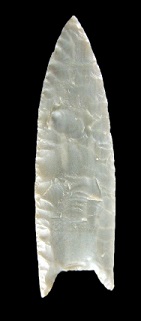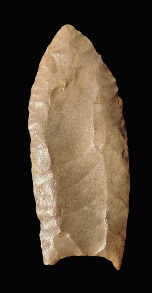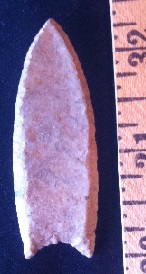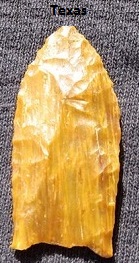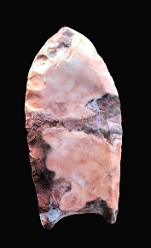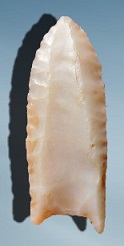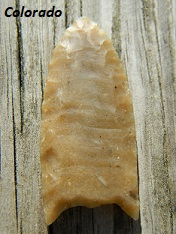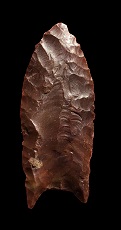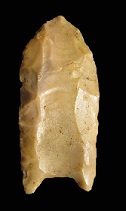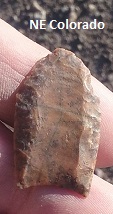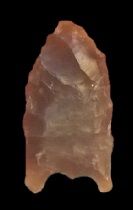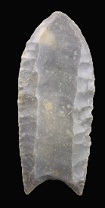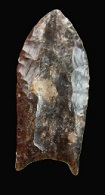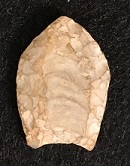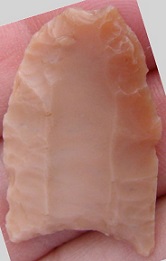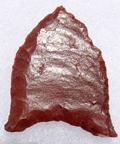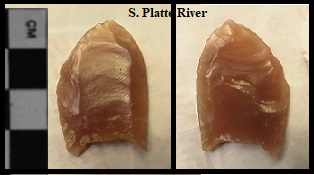Outline is Representative of Size and Shape:
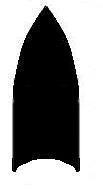
Name Details:
Identified By: Jesse D. Figgins (named) / H.M. Wormington (described)
Named For: Type Site location
Date Identified: 1926 / 1957
Type Site: Wild Horse Arroyo (Folsom Site), Union County, New Mexico
Identified By: Jesse D. Figgins (named) / H.M. Wormington (described)
Named For: Type Site location
Date Identified: 1926 / 1957
Type Site: Wild Horse Arroyo (Folsom Site), Union County, New Mexico
Point Validity:
Valid type
Figgins was a pioneering archaeologist and Director of the Museum of Natural History in Denver, Colorado. This type was named in a professional publication and is widely accepted professionally. This is a valid type.
Figgins was a pioneering archaeologist and Director of the Museum of Natural History in Denver, Colorado. This type was named in a professional publication and is widely accepted professionally. This is a valid type.
Folsom Fluted
Cluster: Folsom Cluster Description of Physical Characteristics and Flaking Pattern:
This is a thin medium lanceolate point with a flattened biconcave cross section. The blade is primarily excurvate with parallel sides. The widest part of the blade generally occurs at the top one third to one half of the blade giving the point a “stub nosed” appearance. The base of the blade is primarily straight, but may flare out at the ears giving the point a recurvate blade. The base concave with many examples being deeply concave with heavy basal and hafting region grinding. Some examples has the remnants of a nipple at the center of the base which is the fluting platform remnants. The faces of the blade are fluted most commonly the entire length of the blade, but may only extend to sixty percent of the face. This point is finished with fine pressure flaking along the edges.
Size Measurements:
Length - 22 to 80 mm (average 46 mm), Max Blade Width - 13 to 28 mm (average 22 mm). Basal Width - 16 to 22 mm (average 18 mm), Thickness - 4 to 7 mm
Length - 22 to 80 mm (average 46 mm), Max Blade Width - 13 to 28 mm (average 22 mm). Basal Width - 16 to 22 mm (average 18 mm), Thickness - 4 to 7 mm
Commonly Utilized Material:
Locally available high quality cherts and materials. Heat treatment is not used on this type.
Locally available high quality cherts and materials. Heat treatment is not used on this type.
Additional Comments:
This point is thought to be the pinnacle of the fluting technology. The flute was made by creating a nipple platform at the center of the base. The remnants of the nipple may be present on completed examples. (Justice, 1987 / Morrow, 2016).
The flaking technique is thought to be the same as seen on the Cumberland points and Gainey Clovis points (Justice, 1987).
Suhm and Krieger (1952) note that these points are associated with Pleistocene bison ranges, but, under controlled excavations, these points are never found in association with older Clovis point or newer Cody Complex points.
Morrow (2016) notes that there are many fluted points that can be mistaken for Folsom point. Re-sharpened and reworked points can reduce the blade extending the the flute / blade ratio until the flute extends the entire length of the blade which will give the point a Folsom appearance. Folsom points are generally distinguishable by their extreme thinness and fine pressure retouch.
This point is thought to be the pinnacle of the fluting technology. The flute was made by creating a nipple platform at the center of the base. The remnants of the nipple may be present on completed examples. (Justice, 1987 / Morrow, 2016).
The flaking technique is thought to be the same as seen on the Cumberland points and Gainey Clovis points (Justice, 1987).
Suhm and Krieger (1952) note that these points are associated with Pleistocene bison ranges, but, under controlled excavations, these points are never found in association with older Clovis point or newer Cody Complex points.
Morrow (2016) notes that there are many fluted points that can be mistaken for Folsom point. Re-sharpened and reworked points can reduce the blade extending the the flute / blade ratio until the flute extends the entire length of the blade which will give the point a Folsom appearance. Folsom points are generally distinguishable by their extreme thinness and fine pressure retouch.
Distribution: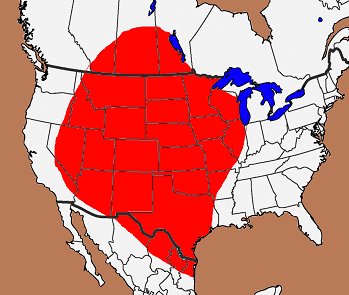

Distribution Comments:
This point is primarily found in the western Plains region of the United States and Canada and into the Continental Divide. This point is found with diminished frequency into the Great Basin to the west and into the Great Lakes region to the east.
This point is primarily found in the western Plains region of the United States and Canada and into the Continental Divide. This point is found with diminished frequency into the Great Basin to the west and into the Great Lakes region to the east.
Age / Periods:
Date: 10,900 - 9,500 B.P.
Cultural Period: Transitional Paleo
Glacial Period: Late Pleistocene
Culture:
Date: 10,900 - 9,500 B.P.
Cultural Period: Transitional Paleo
Glacial Period: Late Pleistocene
Culture:
Age Details:
Similar Points:
Alder, Allen, Angostura, Arkabutla, Belen, Clovis, Coldwater, Cumberland, Golondrina, Goshen, Green River, McKean, Midland, Milnesand, Plainview
Alder, Allen, Angostura, Arkabutla, Belen, Clovis, Coldwater, Cumberland, Golondrina, Goshen, Green River, McKean, Midland, Milnesand, Plainview
Other points in this cluster / Related / Associated Points:

